
Picture created with Stable Diffusion
2022 – the year of Generative AI.
Is it hype? Definitely!
But probably also the start of the next phase of AI development and adaptation.
Maybe 2022 will be seen similarly to 2012, when Alexnet made the breakthrough for image recognition with AI. This was the beginning of the exponential development of machine learning in the last 10 years. And 2022 could be a similar moment, this time through developments in the field of Generative AI.
What is it about? Let’s ask GPT-3 from OpenAI
Q: what is Generative AI?
GPT-3: Generative AI is an artificial intelligence (AI) technique that uses machine learning algorithms to generate new data that is based on existing data. Generative AI algorithms can be used to create new images, audio, text and other types of data. Generative AI can also be used to create variations on existing data, such as creating a different text based on existing text.
In my last blogpost, I reported on Large Language Models and Transformers. Through them, texts can be generated, summarized or questions can be answered. This is a part of generative AI
GPT-3 from OpenAI is the most famous model now being used by more and more startups and companies. This makes the technology more accessible to people, whether for professional or personal use.
Many software tools use GPT-3 or similar models for new features. Notion , Craft , Reader , you.com or Elicit as examples I use myself.
But also Microsoft or Salesforce use these technologies in their applications.
Jasper AI, a startup that develops enterprise solutions based on GPT-3, has closed an investment round of 125M this year.
ChatGPT
In recent weeks, ChatGPT has been making headlines. Developed also by OpenAI, this chatbot is based on GPT-3 but can engage in a dialogue and “remember” given answers.
After just 5 days, ChatGPT had more than 1 million users.

Source: Ingo Hoffmann
There are countless articles and experiments with ChatGPT (see recommendation section at the end of the post ).
On the one hand, it is fascinating to see what this technology can do. On the other hand, there are many open questions and problems.
The models do not know “facts”, they do not have an understanding of the world as we know it. Therefore, the answers may be wrong, the written texts may not correspond to the facts.
There are many open questions: what does this mean for essays and student research papers, and more generally for writing texts. How do we deal with generated texts in science. What does this mean for fake news? What does this mean for copyright and IP – both for training models and for the texts generated from them?
(Gary Marcus addresses this in great detail in his newsletters)
Text-to-Image
We need to look at another area of Generative AI that has had breakthroughs this year: the “text-to-image” generators such as Dall-e 2 , Midjourney , and Stable Diffusion.
These can be used to generate images from text. Often in breathtaking quality.
You can find these images almost everywhere. Anyone can try this out . There are a lot of apps and websites that offer these possibilities often for free.
On my Mac, I have installed Diffusion Bee and can use it to create images locally on my computer. I can run an open source model trained with millions of images locally on my computer. Free of charge. This was unthinkable just a few months ago.
Today, the ability to generate images can be found in applications like Canva but also no-code software like Softr.
This is particularly due to Stable Diffusion, a text-to-image model from Stability AI that was released as an open source solution this year. This allowed developers to incorporate this model into their solutions and services, allowing for free software or affordable new services to be provided
Vendors like OpenAI have significantly reduced their prices, too.
Stability.ai , the developers of Stable Diffusion have raised over $100 million in funding with a valuation of over $1 billion. This is a very attractive topic for investors.
Of course, there is much light and much shadow here as well.
Is this technology fostering or hindering creativity? Will creative jobs disappear? What about the rights to the content used to train these models (and thus also partly responsible for the results)? What about the copyright of the results? And, above all, how do we deal with fake images?
Kevin Kelly, the founder of Wired, has dealt with the topic very intensively and published a very readable article
I have spent the past six months using AIs to create thousands of striking images, often losing a night’s sleep in the unending quest to find _just one more_ beauty hidden in the code. And after interviewing the creators, power users, and other early adopters of these generators, I can make a very clear prediction: Generative AI will alter how we design just about everything. Oh, and not a single human artist will lose their job because of this new technology.
Keven Kelly – Wired
Generative AI is not a completely new development.
Already a few years ago, very realistic images were generated using so-called GANs (Generative Adversarial Networks), which were also used to produce fake images. The generation of text is also not entirely new, GPT-2 was already published by OpenAI in 2018, GPT-3 in 2020.
However, both the quality and access to these models were limited.
What has changed this year?
First and foremost, new open source models have been developed that have made Generative AI much more accessible
Bloom as an alternative to GPT-3. Stable Diffusion as an alternative to DALL-E.
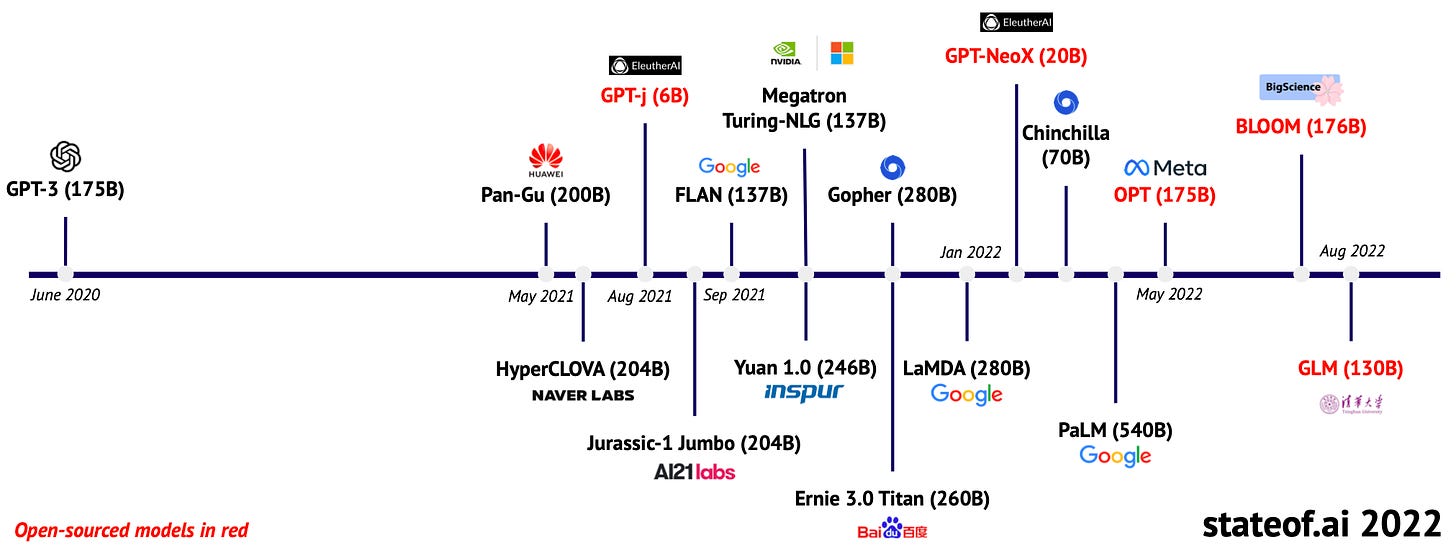
Source: State of AI Report 2022
Training these Generative AI models is very computationally intensive and expensive. Therefore, access was limited.
These open source offerings have significantly lowered the price of the previous solution and made access easier for many startups and users.
OpenAI has also opened up access for its models.
As a result, new solutions are now emerging almost daily. And from this, hype is emerging .
Generative AI is at the beginning of the “Peak of Inflated Expectations” in Gartner’s latest Hype Cycle.
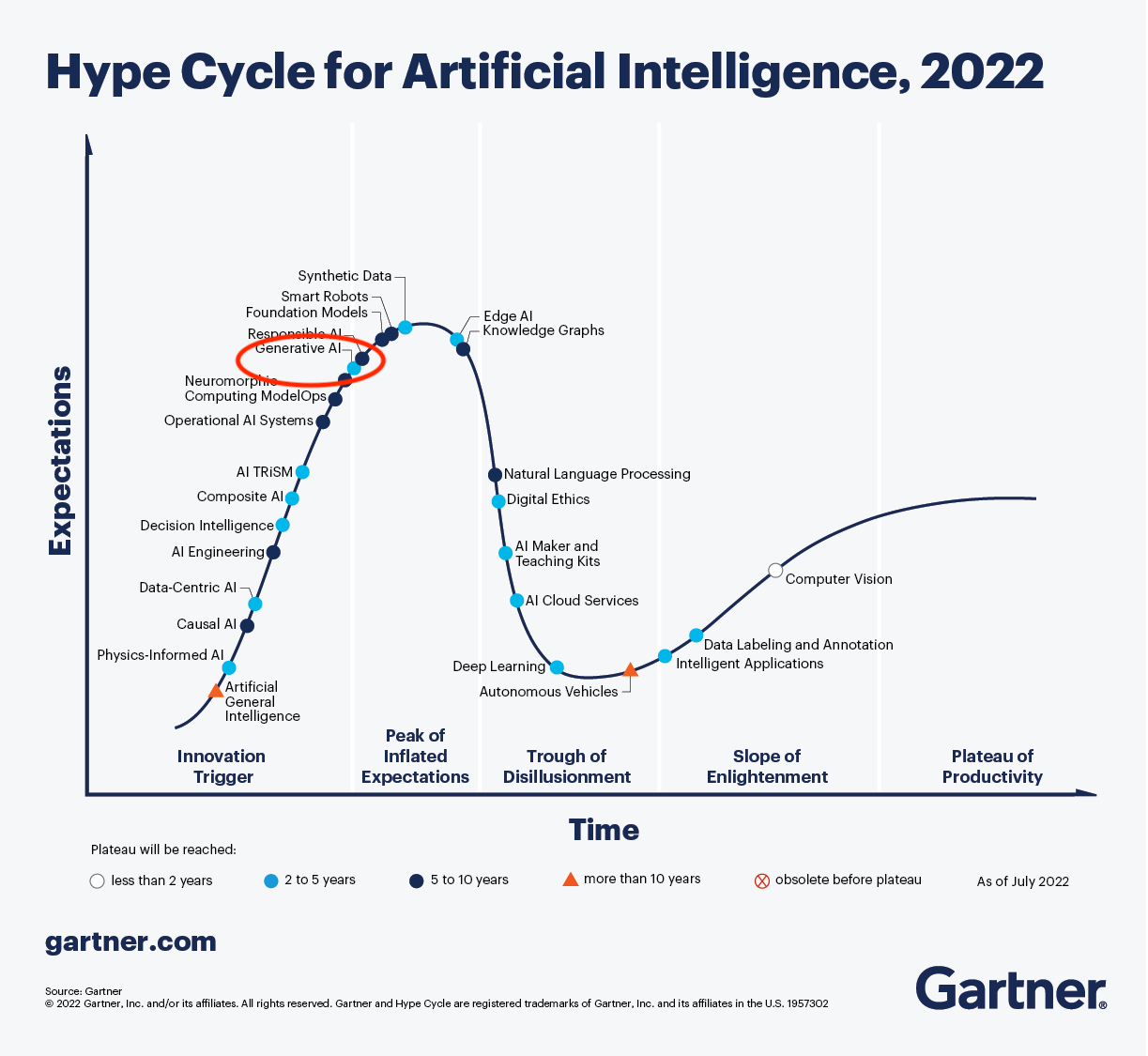
Source: Gartner
This is matched by Forrester’s prediction that 10% of employees in Fortune 500 companies will be producing content using Generative AI in 2023.
Many of the applications today still look like gimmicks. There are still many unanswered questions and problems, as we have already seen.
But so was the case 10 years ago when the first machine learning image recognition solutions emerged.
From this, a large number of productive applications have evolved.
Not only in image recognition (as found on many smartphones, and also in industry e.g. quality control). Machine learning insights have also been applied to other types of data, as we can see today in a variety of productive solutions.
In logistics, industry supply chains, healthcare, purchasing or the use of Alexa, Siri and co.
What all these applications have in common is that patterns can be recognized in a large amount of data, and predictions can be made from them (“There is a dog in the picture.”)
Generative AI will also develop into further areas and has already penetrated areas such as video creation or 3D models.
This gives rise to many potential application areas.
Investment Opportunity
It is as important for investors to understand as it is for the potential users
Some investors have already recognized this. Pitchbook data shows that venture capital investment in generative AI startups has reached $2.1B this year, up 425% since 2020, according to the Financial Times (FT).
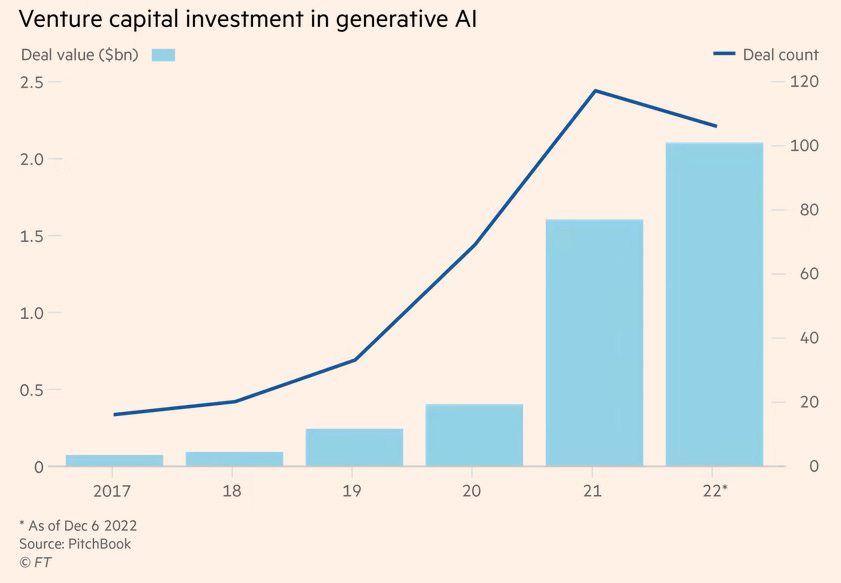
Source: FT
Sequoia revealed in a blog post what applications and developments they expect to see in the next few years.

Source: Sequoia
These developments include
- Text models, which will improve significantly in quality and will be developed for specific application areas in particular
- Support for programming through the automatic generation of software code
- Creation of images and photos from text
- Creation of human speech, which can be used especially for podcasts or videos
- Creation of videos and 3-D model from text
And many other fields, such as biology or chemistry, for example proteins or molecules can be created with Generative AI
It is clear that we are only at the beginning of this development. Similar to Gartner, Sequoia also expects the first commercial breakthroughs in the next 2-3 years, making Generative AI so interesting for startups and investors today
CBinsights has published a map of 250 startups already underway in this field.
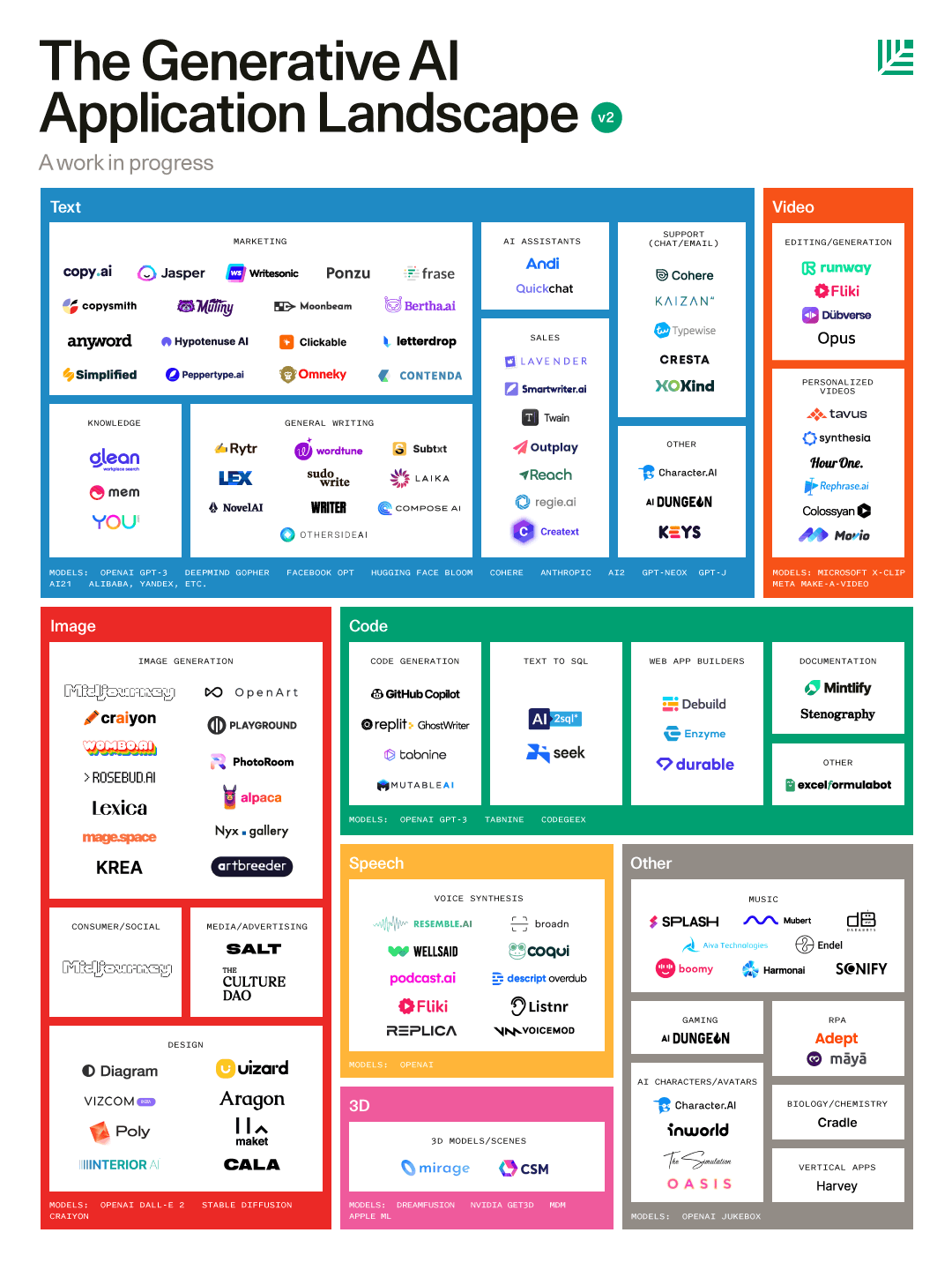
Source: CB Insights
And Base10, a technology investment firm, also covered the topic of Generative AI in a study and created a Generative AI Trend Map of 300 startups
What we’ve learned suggests that Artificial Intelligence will be the next platform shift-following cloud, social, and mobile-and is in 2022 where cloud was in 2006-07, with Generative AI leading the rapid charge.
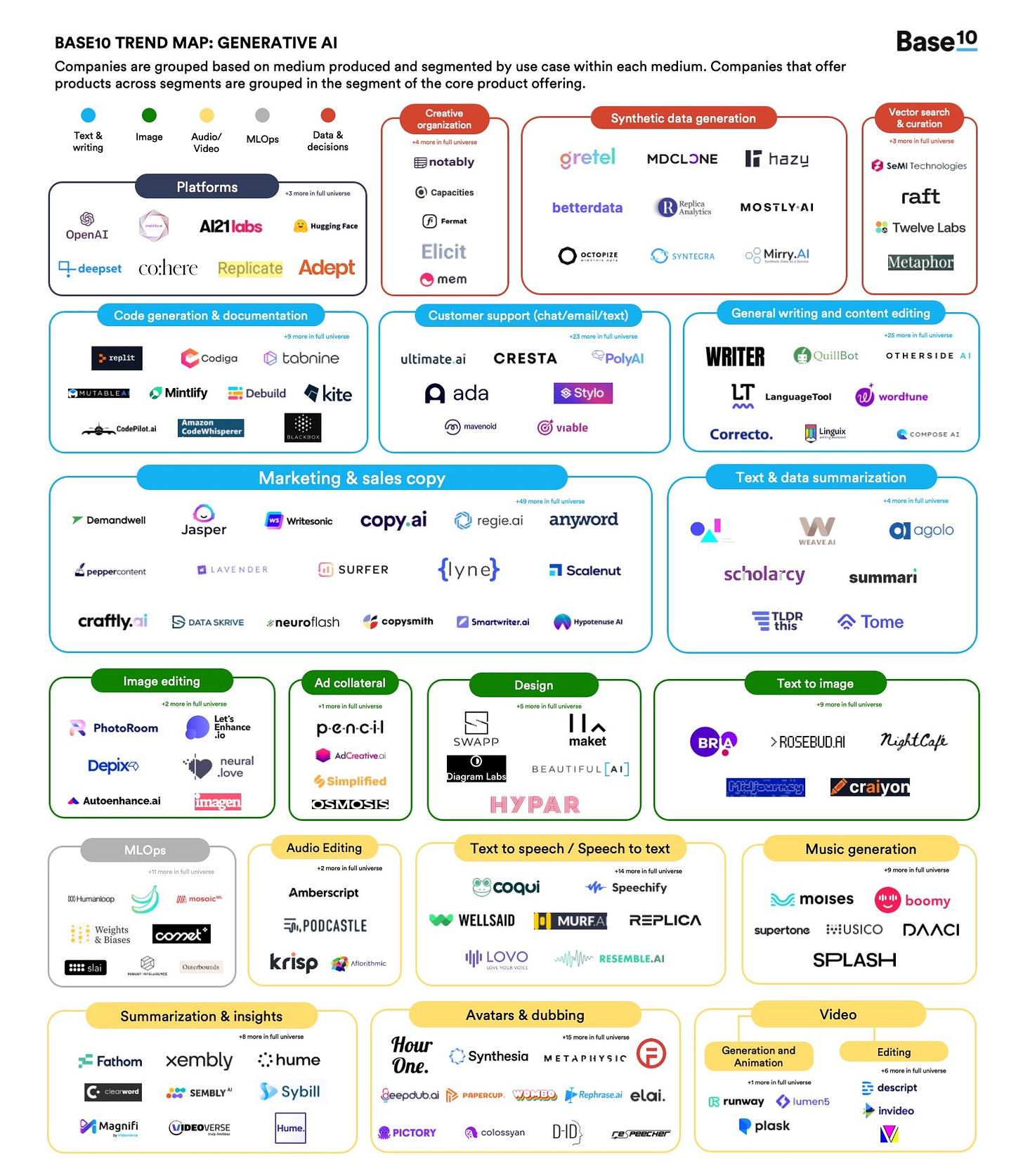
Source: Base10.vc
Conclusion
In the last decade, many AI solutions have been developed that can recognize patterns from large data sets using machine learning and make predictions from them.
In the coming years, new solutions will emerge that can create new patterns from inputs such as text. Patterns like images, videos, texts and much more that we cannot (yet) imagine today.
Microsoft, for example, has filed a patent for the creation of AI-generated music/soundtracks/audio in an extensive range of media, including movies, video games, live recordings and related fields.
It is worth continuing to engage with this topic, with the possibilities that this technology opens up for us, with the challenges it brings and how we can address them, with the question of what this technology can do today and how it will develop.
I see the Generative AI development positively, despite all the open and critical questions that still exist
Happy holidays
More reading recommendations:
You can find even more AI Tools here: https://www.futurepedia.io/
Harvard Business Review: How Generative AI Is Changing Creative Work
Sequoia – Generative AI: A Creative New World
Aleksa Gordic, an AI researcher with DeepMind: Has There Been A Second AI Big Bang?
5 ways Forrester predicts AI will be “indispensable” in 2023
Tim O’Reilly: AI Is A Mirror, Not A Master
Gary Marcus is looking at the challenges of Generative AI in his newsletter
Ethan Mollick: Four Paths to the Revelation
Stephen Marche: The College Essay Is Dead
Economist: Artificial intelligence is permeating business at last
Sequoia’s Sonya Huang: The generative AI hype is ‘absolutely justified’
AI will thrive in 3 key areas in 2023, despite economic conditions



